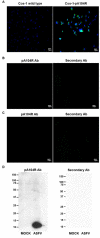Towards the Generation of an ASFV-pA104R DISC Mutant and a Complementary Cell Line-A Potential Methodology for the Production of a Vaccine Candidate
- PMID: 31323824
- PMCID: PMC6789577
- DOI: 10.3390/vaccines7030068
Towards the Generation of an ASFV-pA104R DISC Mutant and a Complementary Cell Line-A Potential Methodology for the Production of a Vaccine Candidate
Abstract
African swine fever (ASF) is a fatal viral disease of domestic swine and wild boar, considered one of the main threats for global pig husbandry. Despite enormous efforts, to date, neither the classical vaccine formulations nor the use of protein subunits proved to be efficient to prevent this disease. Under this scenario, new strategies have been proposed including the development of disabled infectious single cycle (DISC) or replication-defective mutants as potential immunizing agents against the ASF virus (ASFV). In this study, we describe the methodology to generate an ASFV-DISC mutant by homologous recombination, lacking the A104R gene, which was replaced by the selection marker (GUS gene). The recombinant viruses were identified when the infected cells acquired a blue color in the presence of X-Gluc (100 µg/mL), which is the substrate for the GUS gene. Since these viral particles result from loss-of-function mutations, being unable to replicate, helper-cell lines expressing the viral pA104R protein were produced. Vero and COS-1 cell lines were transfected by different methods, both physical and chemical, in order to stably express the ASFV-pA104R. Best results were obtained by using Lipofectamine 2000 and Nucleofection methodology of Vero with the pIRESneo vector and by using Flp-FRT site-directed recombination technology system in Flp-In CV-1 cells (transformed COS-1 cells with a single integration site in a transcriptional active region). In order to ensure an efficient and stable integration of the viral ORF on the host cellular genome, the maintenance of the insert was verified by PCR and its expression by immunofluorescence and immunoblot analysis. Although the isolation of the recombinant virus was not achieved, the confirmation of ASFV-ΔA104R sequence, and the detection of the recombinant mutant through three passages, suggest that this approach is feasible and could be a potential strategy to generate safe and efficient DISC vaccine candidates.
Keywords: ASFV; DISC; helper cell line; pA104R; vaccine.
Conflict of interest statement
The authors declare no conflict of interest, financial or otherwise.
Figures







References
-
- Gulenkin V.M., Korennoy F.I., Karaulov A.K., Dudnikov S.A. Cartographical analysis of African swine fever outbreaks in the territory of the Russian Federation and computer modeling of the basic reproduction ratio. Prev. Vet. Med. 2011;102:167–174. doi: 10.1016/j.prevetmed.2011.07.004. - DOI - PubMed
-
- WAHID WAHID WAHID Database. DISEASE Information. [(accessed on 1 March 2019)]; Available online: https://www.oie.int/wahis_2/public/wahid.php/Diseaseinformation/Immsummary.
Grants and funding
LinkOut - more resources
Full Text Sources
Research Materials

